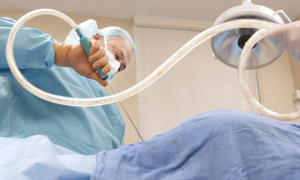Neural Foraminal Stenosis
Today I went to see my pain management doctor. My PT thought I had spinal stenosis. I looked it up on the internet because I am an anal internet searcher. I thought the symptoms I had matched that diagnosis. I saw the PA before my doc came in/ The PA thinks I have Neural Foraminal Stenosis.
I had never heard of that before but I have been reading about it today. It is a type of stenosis but it doesn't seem to happen in the spinal canal. I am going to get a shot in the sacrospinal ligament in two weeks! That is exactly where my pain originates so I hope it tales away some of the major pain!
Neural foraminal stenosis refers to compression of a spinal nerve as it leaves the spinal canal through the foramen (the opening between the vertebrae through which spinal nerve roots travel and exit to other parts of the body).
Neural foraminal stenosis occurs when the foramen of the neck (cervical stenosis), the upper part of the back (thoracic stenosis), or the lower back (lumbar stenosis), compress or narrow, trapping the nerve root.
Neural foraminal stenosis may occur in either the lower back (lumbar spine) or the neck (cervical spine), and be caused by an osteophyte, a foraminal herniated disc, or collapse of the disc space.
In patients with lower back and leg pain, lumbar foraminal stenosis (LFS) is one of the most important pathologies, especially for predominant radicular symptoms. LFS pathology can develop as a result of progressing spinal degeneration and is characterized by exacerbation with foraminal narrowing caused by lumbar extension (Kemp's sign). However, there is a lack of critical clinical findings for LFS pathology. Therefore, patients with robust and persistent leg pain, which is exacerbated by lumbar extension, should be suspected of LFS.
Scary to watch!!
When I was chatting with my pain management doctor, I asked her if I had to be put out for the shot. She said most people choose that option. I told her that I am nervous because my 18 year old daughter died after having anesthesia and surgery in an outpatient plastic surgeon doctor's office. She said to me, "OMG, I remember that story. It was in the newspaper and on the news, right?" I said yes and she kept telling me how sorry she was. She said that the doctor did not do the right thing and should have had Amy transported to a hospital right away. I am glad that people remember Amy and what happened to her.
A Philadelphia jury awarded a $20.5 million verdict Friday to the parents of an 18-year-old college student who allegedly died from a liposuction procedure gone wrong.
 Of the $20.5 million award, $15 million was for punitive damages.
Of the $20.5 million award, $15 million was for punitive damages.
The jury returned the verdict seven years to the day of the elective liposuction Amy Fledderman, 18, sought for her chin, abdomen, and flanks with plastic surgeon Dr. Richard P. Glunk on May 23, 2001, according to court papers.
Amy Fledderman’s parents, Daniel H. and Colleen M. Fledderman, sobbed as the 12-member jury returned a unanimous verdict against Glunk and nurse anesthetist Edward DeStefano late Friday morning.
In the Fledderman v. Glunk wrongful death and survival action, the jury awarded $15 million in punitive damages, $3.5 million under the Survival Act, $2 million for Glunk allegedly negligently inflicting emotional distress on Colleen Fledderman, $20,000 under the Wrongful Death Act and $5,000 for Glunk’s alleged failure to obtain Amy Fledderman’s informed consent.
Plaintiffs’ attorney Slade H. McLaughlin of Philadelphia’s McLaughlin & Lauricella said in an e-mail that the $15 million in punitive damages and $5.525 million in compensatory damages is within the 9 to 1 punitive damages cap ratio required by the U.S. Supreme Court decision in Campbell v. State Farm. He also noted that the wrongful death damages are almost exactly equal to the Fledderman’s funeral costs, and the informed consent damages were the costs of her surgery.
The jury found Glunk 75 percent liable for Amy Fledderman’s death and found DeStefano 25 percent liable regarding Fledderman’s medical care and treatment.
A five-week trial was held in front of Philadelphia Common Pleas Judge Sheldon C. Jelin. The jury deliberated for close to 2.5 days.
According to the plaintiffs’ pretrial memorandum, a blood vessel in Amy Fledderman’s neck was severed during the liposuction, and she was administered medication to which she was allergic. Despite a respiratory emergency, the plaintiffs’ memorandum alleged, Glunk and DeStefano kept Fledderman in Glunk’s office for 2.5 hours and did not call an ambulance until she was on the verge of death, including appearing cyanotic, or blue, and her oxygen levels had dropped from the normal high 90s to the 60s.
Fledderman died two days later as she was being transferred from Montgomery Hospital to the Hospital of the University of Pennsylvania, the plaintiffs’ memorandum said.
The Plaintiffs’ memorandum said Fledderman had an agonizing death and spent the 24 hours before dying in severe pain, intubated and vomiting blood. “Dr. Glunk and his staff engaged in a massive cover up, lying to the Pennsylvania Department of State investigators, to the Pennsylvania Department of Health investigators, and to detectives from the Montgomery County District Attorney’s Office,” the plaintiffs’ memorandum alleged. “It was not until the civil suit, during pointed questioning of witnesses by plaintiffs’ counsel, Slade McLaughlin, that the truth was finally drawn from under the rock where Dr. Glunk and his staff had attempted to hide it.”
Daniel and Colleen Fledderman said in an interview immediately following the jury verdict that without the aggressive and whole-hearted pursuit of their civil action by their attorneys Slade McLaughlin and his associate, Maxwell S. Kennerly, that they would not have received “justice” for their daughter.
They said they had never wanted to settle the case, but instead they had wanted to take the case before a jury in the hopes that a civil grouping of Glunk’s peers would believe their side of the case and make sure with their verdict that Glunk might not ever see any more patients.
McLaughlin said a decision is still pending regarding a hearing held in January over Glunk’s medical license.
“It warmed my heart to see the Fleddermans in such a state,” McLaughlin said in an interview following the verdict. “It was such a good feeling to turn all that hard work into a home run.”
Glunk’s liposuction privileges had been restricted at Main Line Health Hospitals, and he was required to be under the supervision of another liposuction surgeon, according to the plaintiffs’ memorandum. Glunk’s King of Prussia office was not licensed by the Pennsylvania Department of Health, the plaintiffs’ memorandum said.
Glunk’s pretrial defense memorandum said that Fledderman had a rough emergence from anesthesia, resulting in short breathing. Glunk’s memorandum said Glunk and his staff monitored her, until her breathing decreased even more and an ambulance needed to be summoned. Glunk then argued that Fledderman was intubated incorrectly by paramedic Samuel Paolella of the Lafayette Ambulance and Rescue Squad during her transportation to Montgomery Hospital, causing her oxygen saturation to decline to 64 percent.
McLaughlin said that Glunk changed his theory of the case just before trial from blaming the ambulance squad to saying that an unavoidable medical problem –a fat embolism during the liposuction procedure – caused Fledderman’s death.
DeStefano also argued in his pretrial defense memorandum that a fat embolism had caused Fledderman’s death.
“Unfortunately, the plaintiff developed a rare, but recognized complication of the liposuction procedure – fat emboli, that led to her death,” DeStefano’s memorandum said.
Dean F. Murtagh of German Gallagher & Murtagh represented Glunk. I. Steven Levy of White & Williams represented DeStefano. Both attorneys could not be reached for comment.
Daniel S. Altschuler of Post & Schell represented Lafayette Ambulance and Rescue Squad and paramedic Samuel Paolella.
Those two defendants got out of the case on a directed verdict, according to interviews.
McLaughlin said the case was vigorously defended, so he wouldn’t have been surprised at any verdict. Both Glunk and DeStefano testified that they were blameless in Fledderman’s death, so McLaughlin said the jury had to choose between the two sides and whom they were going to believe.
McLaughlin said he thinks the defense will appeal, and he will seek delay damages.
The Legal Intelligencer – May 27, 2008 | By Amaris Elliott-Engel








Comments
Post a Comment